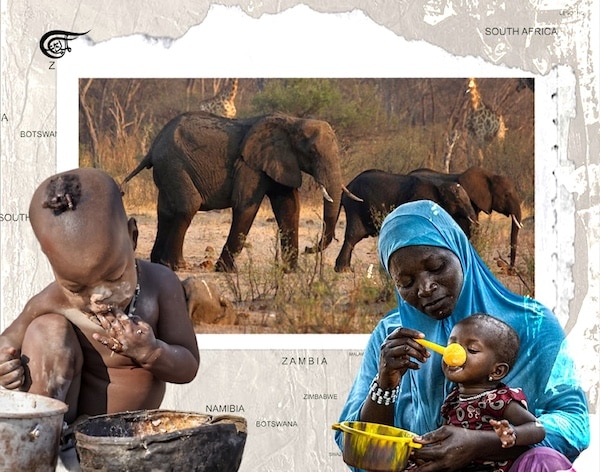Namibia recently announced plans to kill 700 animals, including elephants, to feed some of its most vulnerable communities. It is the latest country in southern Africa to turn to the forest to alleviate hunger as the region reels under the effects of a severe El Ninõ-induced drought that has left close to 70 million people facing starvation. The drought-ravaged food crops in six southern African nations resulted in the growing hunger that is expected to last until the first quarter of 2025.
In what is regarded as the region’s worst drought in more than three decades, Botswana, Namibia, Lesotho, Malawi, Zambia, and Zimbabwe have all declared a national state of food disasters and are scrambling to mobilize resources to avert mass starvation. UNICEF says 7.4 million children in these six southern African countries are living in child food poverty—of which over 2 million are surviving on extremely poor diets that include at most two food groups.
Abundant wildlife resources
The region also happens to be home to the highest concentrations of wildlife resources with countries like Botswana, Zimbabwe, Namibia, Zambia, and South Africa already struggling with an overpopulation of animals like elephants.
As a result, Zimbabwe and Botswana have also increased forays into the forests to harvest their wildlife resources for the benefit of their hungry populations. The move by these wildlife-rich African countries is two-pronged: to reduce the wildlife numbers and to enable hunger-stricken citizens to access meat protein to supplement their threadbare diets.
The drought condition, which has previously resulted in the death of tens of thousands of wildlife in these countries, is expected to result in even more deaths this year as the situation is more severe this time. This is what is pushing authorities in these countries to preempt these deaths by culling off some of the animals.
Thousands of animals targeted
On August 26, Namibia’s Ministry of Environment, Forestry, and Tourism announced that more than 700 animals have been earmarked, including 83 elephants, 30 hippos, 100 elands and 300 zebras. It said the animals would come from national parks that have sustainable game populations. The move, it said, would ease the strain on grazing and water in its drought-stricken national parks, while also making meat available to feed vulnerable communities.
Botswana, a nation of 2,4 million that is having difficulties managing its abundant wildlife population, including its 132,000-elephant herd—the world’s largest—in March this year extended its trophy hunting season by five months in a bid to reduce these numbers. All meat from the carcasses of the hunted animals goes to feed communities that co-exist with the wildlife.
A government declaration dated 15 March 2024 extended Botswana’s open season for hunting elephants from 2 April 2024 until 31 January 2025. Typically, the hunting season would only last from mid-April to mid-September. The declaration therefore adds five more months of elephant hunting.
Chieftainess Rebecca Banika from Botswana’s elephant-rich Chobe district, whose community relies on income from trophy hunting, said she is happy with the government’s decision to extend the hunting season, saying this would mean more meat for her community.
“I think it will help in terms of nutrition and conservatism as these will also reduce the number of animals as they are equally facing severe drought,” Banika said in an interview. “The old bulls need to be culled before being killed by drought and lack of food. It’s rather better the animals be killed and be consumed by the community members,” she added.
The meat comes in addition to the over $5 million that Batswana communities earn annually from trophy hunting.
Zimbabwe mulls another cull
In Zimbabwe, lawmakers are pushing for something similar to the move taken by Botswana. Joseph Bonda, the legislator for Hwange, whose community co-exists with wildlife in the Hwange National Park, the country’s largest game reserve, says they would want the central government to increase the hunting quota for the Rural District Councils so that more elephants and other animals can be hunted and the resultant meat goes toward feeding the hungry in rural areas.
“Whether it is government parks culling it’s all fine, it is super for community nourishment; if it’s (trophy) hunts, it would be better because surely the beasts won’t get killed for meat only,” Bonda said in an interview.
Zimbabwe with its own bludgeoning wildlife population, including a 100,000-elephant population, is facing increased cases of human-wildlife conflict (HWC) as the animals encroach into human settlements in search of pasture and water.
Tinashe Farawo, the spokesperson for the Zimbabwe Parks and Wildlife Management Authority (ZimParks), says while at the moment they have no animals specifically earmarked for meat, the department is responding to an increased number of HWC cases in which they put down the problem animals and all the meat is given to the communities.
Farawo says under the CITES convention, the country has an annual elephant quota of 500, which is the number of elephants that can be killed for local consumption, but the authority has not been considering harvesting this quota as even more animals are killed in trophy hunting and in cases of HWC, with all the meat going the local communities as well as to needy cases like the country’s prisons.
Environment, Climate, and Wildlife Minister Sithembiso Nyoni has told Parliament that wildlife culling is being considered. This would not be the first time for Zimbabwe to do so as during the drought of 1992 some 5,000 elephants were killed to relieve hunger.

